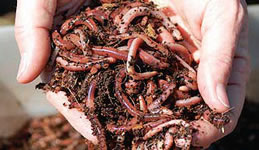 Rising cost of farm inputs in the country has seen some leading flower farms in the country rethink other innovative ways of cutting chemical based fertilizers cost in a sustainable and environmentally friendly way.
Rising cost of farm inputs in the country has seen some leading flower farms in the country rethink other innovative ways of cutting chemical based fertilizers cost in a sustainable and environmentally friendly way.
A leading rose grower in Kenya, has embraced a relatively new but simple system to operate composting technology known as Vermicomposting. This refers to the production of plant nutrient rich excreta of earthworms and decomposed matter.
Earthworms play a vital role in plant growth and it is quite possible to effect quick change over for sustainable agriculture by harnessing the brand new vermicompost technology to the soil. This vermicompost have enzymes, secretions of earthworms which stimulate growth and yield of crops and even develop resistance in crops receiving this spray. Also known as vermiwash, worm compost, vermicast, worm castings, worm humus or worm manure, vermicompost is similar to plain compost, except that it uses worms in addition to microbes and bacteria to turn organic waste into a nutrient-rich fertilizer.
The technology has gone a long way in reducing the cost of fertilizers needed for the growth of a healthy flower. It has also proved completely safe to plants and easy to produce. Explaining how vermicompost is prepared the grower said the farm acquires cow dung from the neighbouring community at a low cost.The dung is then put in barrels and red earthworms rarely found in soil are introduced. The barrel is usually completely open on one side with a hole on the bottom end to accommodate a vertical limb of a ‘T’ jointed tube in a way that about half to one inch of the tube projects into the barrel.
To one end of the horizontal limb is attached a tap while the other end is kept closed. This serves as an emergency opening to clean the ‘T’ jointed tube if it gets clogged. A container to collect the liquid compost is placed on the open end of the tube in which the vermicompost is collected in form of liquid.
How vermicomposting work
After procuring a container and setting it up the worms are fed on the cow dung after which they secrete it. Water is poured into these barrels to wash the excreta which are then collected inside a container placed on the open tap beneath the barrels. Earthworm has efficiency to consume all types of organic rich waste material including vegetable waste, industrial and other organic waste.
In addition to increased nutrient levels, worm castings contain millions of microbes which help break down nutrients already present in the soil into plant available forms.
As the worms deposit their castings, their mucous is a beneficial component absent from compost produced by hot or cold composting. The mucous component slows the release of nutrients preventing them from washing away with the first watering. Worm compost is usually too rich for use alone as a seed starter. It is useful as a top dressing and as an addition to potting mixes at a rate of one part castings to 4 parts mix.
Unlike compost, which can work its magic in a pile in your backyard, vermicompost requires a bit more structure to work, usually in the form of a bin. Bins can be made out just about anything, but they require drainage and air flow to be built in, so things like Styrofoam (very insulating, and may release toxins into the worms’ environment) and metal (too conductive of heat and cold) are generally less desirable, and plastic requires more drainage than wood and can’t absorb moisture. The design of a bin usually depends on where you want to store the bin and how they wish to feed the worms.
Vermicomposting tips
In warm climates, keep the bin in the shade or away from midday direct sun just like compost, it should stay moist. Quantities of cow dung or whatever waste material you are using to make the compost, added depends on the size of the worm population; at first, feed the worms approximately one-half their body weight in kitchen scraps a day at most.
That is, if you have one pound of worms, feed them about 1/2 pounds of kitchen scraps each day. When they become more established, you can feed them closer to their entire body weight, though it’s best to wait to add new food until the old food has been processed by the worms.
Waste that can be used for vermicomposting
Agricultural waste; Agricultural fields: stubble waste, husk, straw, and farmyard manure. Others include stems, leaf matter, fruit rind, pulp and stubble. But be careful while handling an all-citric waste. Animal waste include; dung, urine and biogas slurry Urban solid waste: Kitchen waste from household and restaurants, waste from market yards and places of worship, and sludge from sewage treatment plants. Agro industries: Food processing units: Peel, rind and unused pulp of fruits and vegetables, fine bagasse, press mud and seed husk, stems, leaves and flowers after extraction of oil.
